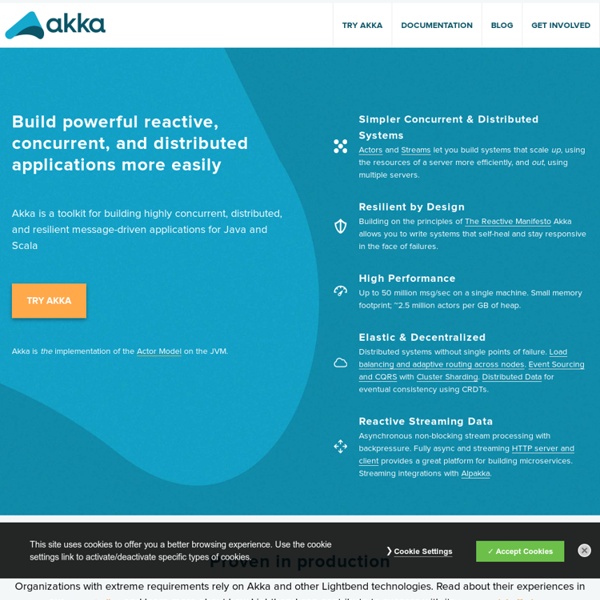



Stack: Overview Get Started Now With Typesafe Activator What is a Reactive application? Reactive applications are a new class of applications that are becoming more and more prevalent in both Consumer and Enterprise-facing environments. Reactive applications are fundamentally different to the traditional web-based or mobile applications seen today and are distinguished by having one or more of the following defining traits: Google Guava – Futures This post is a continuation of my series on Google Guava, this time covering Futures. The Futures class is a collection of static utility methods for working with the Future/ListenableFuture interface. A Future is a handle to an asynchronous task, either a Runnable or Callable, that was submitted to an ExecutorService. The Future interface provides methods for: getting the results of a task, checking if a task is done, or canceling a task. The ListenableFuture interface extends the Future interface and adds the ability to set a completion listener to run once a task is finished. To create a ListenableFuture you first need to decorate an ExecutorService instance like so:
JavaScript JavaScript is classified as a prototype-based scripting language with dynamic typing and first-class functions. This mix of features makes it a multi-paradigm language, supporting object-oriented,[6] imperative, and functional[1][7] programming styles. JavaScript has been standardized in the ECMAScript language specification. Logback Console Plugin for Eclipse Logback-beagle: an Eclipse plug-in for viewing logs During the development process, it is common for developers to print logging events on the console. Typically, the developer will also customize the format of the log output by setting an appropriate layout pattern. Logback-beagle is intended as a replacement for viewing logs via the console. It offers several advantages over the plain-old console: Events of level WARN and ERROR are marked by an orange flag and respectively a red flag.
Cascading Style Sheets CSS is designed primarily to enable the separation of document content from document presentation, including elements such as the layout, colors, and fonts.[1] This separation can improve content accessibility, provide more flexibility and control in the specification of presentation characteristics, enable multiple pages to share formatting, and reduce complexity and repetition in the structural content (such as by allowing for tableless web design). CSS can also allow the same markup page to be presented in different styles for different rendering methods, such as on-screen, in print, by voice (when read out by a speech-based browser or screen reader) and on Braille-based, tactile devices. It can also be used to allow the web page to display differently depending on the screen size or device on which it is being viewed.
High Performance And Smarter Logging 1. Summary Logging, often a back-burner activity in the development cycle can actually be the very lifeline of the development team once the application is in production. Assuming that readers are well acquainted with various logging frameworks like Log4J, SLF4J, etc, this article lays guidelines for 'real-world' production logging, examines its influence on the application quality attributes and also rediscovers a forgotten high performance, smarter logging technique with codes and centralized logging. 2 Introduction Logging is often relegated to a back-burner activity while architecting, designing and developing applications or even when enhancing applications.
HTML5 HTML5 is a markup language used for structuring and presenting content for the World Wide Web and a core technology of the Internet. It is the fifth revision of the HTML standard (created in 1990 and standardized as HTML 4 as of 1997)[2] and, as of December 2012[update], is a candidate recommendation of the World Wide Web Consortium (W3C).[3] Its core aims have been to improve the language with support for the latest multimedia while keeping it easily readable by humans and consistently understood by computers and devices (web browsers, parsers, etc.). HTML5 is intended to subsume not only HTML 4, but also XHTML 1 and DOM Level 2 HTML.[2] History[edit] The Web Hypertext Application Technology Working Group (WHATWG) began work on the new standard in 2004.
Bossie Awards 2010: The best open source software of the year It is now roughly 40-plus years since Richard Stallman released his text editor with the words "Emacs General Public License" in the documentation and 20 some years since the world first saw the phrase "GNU General Public License." Back in those days, finding the best open source software was relatively simple. There was Emacs, and then came vi.
Zoomooz.js Zoomooz is: 6KB gzipped and 18KB minified. This includes everything but jQuery. Make any web page zoom. Latest version: 1.1.9 (Nov 11, 2013, hacky fix for the back and forward buttons #66) Zoomooz is a jQuery plugin for making web page elements zoom. It can be used for making Prezi like slideshows and for zooming to images or other details. NoSQL "Structured storage" redirects here. For the Microsoft technology also known as structured storage, see COM Structured Storage. A NoSQL (often interpreted as Not Only SQL[1][2]) database provides a mechanism for storage and retrieval of data that is modeled in means other than the tabular relations used in relational databases. Motivations for this approach include simplicity of design, horizontal scaling and finer control over availability. The data structure (e.g. key-value, graph, or document) differs from the RDBMS, and therefore some operations are faster in NoSQL and some in RDBMS.
Home · tinkerpop/blueprints Wiki Blueprints is a collection of interfaces, implementations, ouplementations, and test suites for the property graph data model. Blueprints is analogous to the JDBC, but for graph databases. As such, it provides a common set of interfaces to allow developers to plug-and-play their graph database backend.